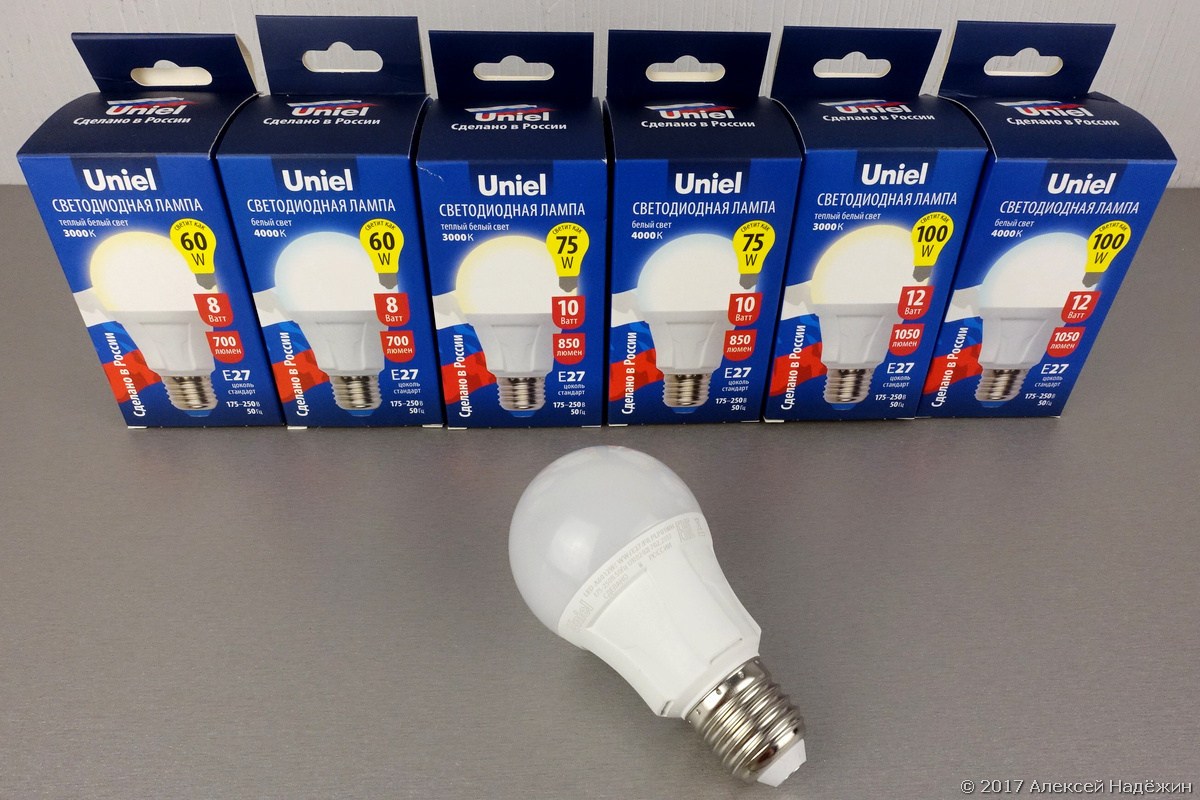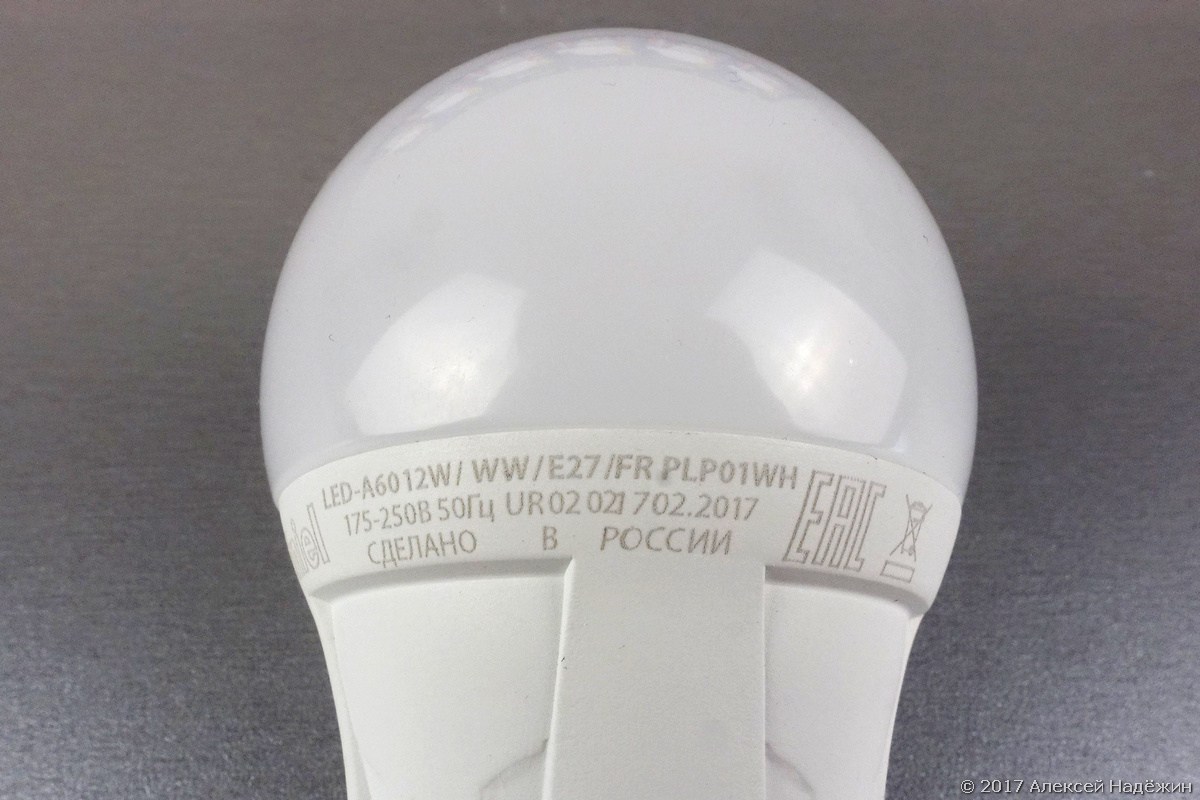Russian LED lamps Uniel
Uniel LED lamps can be found in many large stores. Until recently, all these lamps were made in China, but recently the company opened a factory for the production of LED lamps in Chernogolovka.

So far, Russia has begun production of the most popular lamp models - “pears” with an E27 base, replacing incandescent bulbs of 60, 75 and 100 watts. Lamps are available with warm (3000K) and neutral (4000K) light.

On the Uniel site you can watch a video about the production of lamps. On the body of each lamp there is an inscription "Made in Russia".
')

I tested all six models. The luminous flux of the lamps was measured with a Viso Light Spion instrument, the power consumption of a Robiton PM-2 instrument, the color rendering index, color temperature and pulsation with a Uprtek MK350D instrument .

There is practically no light pulsation in all lamps (the device showed values of 0.1 - 0.3%).
The color rendering index (CRI, Ra) was 81.6-82.6, which allows us to recommend lamps for residential use.
On the packaging of the lamps indicated voltage range 175-250 volts. In fact, 10-watt lamps work without a drop in brightness when the voltage drops to 133 volts, and 8-and 12-watt lamps to 114 volts. Due to such a wide range of operating voltages, lamps can be used where the mains voltage is unstable and can greatly decrease (for example, in rural areas).
The manufacturer claims lamp life of 30,000 hours and gives a 3 year warranty.
With switches that have an indicator, the lamps cannot work (they light up weakly and flash at the same time when this switch is turned off).
The measured luminous flux of lamps with a neutral light of 4000K turned out to be even higher than that claimed by 3-11%. Lamps with a warm 3000K light give 9-10% less light than stated, but this meets the requirements of GOST R 54815-2011 , according to which the measured initial light flux of an LED lamp must be at least 90% of the nominal luminous flux.
The efficiency of 4000K lamps with neutral light was 91-98 lm / W, the lamps with warm light 3000K - 80-89 lm / W, that is, the tested LED lamps consume 9-10 times less energy than incandescent lamps, which give the same amount of light.
According to the results of my measurements, a 60 W incandescent lamp gives about 650 lm at a voltage of 230 V and about 540 lm at a voltage of 220 V, therefore 8-watt Uniel lamps giving 640/775 lm, regardless of voltage, will be brighter than a 60-watt incandescent lamp.
Incandescent 75 W bulbs give about 820 lm at 230 V and about 700 lm at 220 V, so Uniel lamps giving 766/888 lm will also be brighter than 75 watt incandescent bulbs.
The 95-watt incandescent lamp gives 1270 lm at 230 V and 1050 lm at 220 V. It can be assumed that a 100-watt incandescent lamp would yield 1,330 / 1,100 lm. The 12-watt Uniel lamp with a 4000K neutral light gives 1086 lm and can be considered a full-fledged replacement of a 100-watt incandescent lamp. 12-watt lamp with a warm light 3000K gives 953 lm. If the mains voltage is low, it will shine brighter than a 100-watt incandescent lamp, but if it is not less than 220 volts, this lamp will give light as an 85-watt incandescent lamp.
In the table I quoted the prices of the official Uniel online store. On the Internet, these lamps can be found even cheaper, for example, 10-watt lamps cost 105.50 rubles for Online Trade, and 12-watt lamps for 124.90 rubles when buying a box of 10 pieces. It is very cheap for lamps with such characteristics.
Perhaps Russian Uniel LED lamps are now the best in terms of price / quality ratio.
© 2017, Alexey Nadyozhin
PS My previous article on LED lamps: Cutting pears: comparative testing of 60 LED lamps .

So far, Russia has begun production of the most popular lamp models - “pears” with an E27 base, replacing incandescent bulbs of 60, 75 and 100 watts. Lamps are available with warm (3000K) and neutral (4000K) light.

On the Uniel site you can watch a video about the production of lamps. On the body of each lamp there is an inscription "Made in Russia".
')

I tested all six models. The luminous flux of the lamps was measured with a Viso Light Spion instrument, the power consumption of a Robiton PM-2 instrument, the color rendering index, color temperature and pulsation with a Uprtek MK350D instrument .

There is practically no light pulsation in all lamps (the device showed values of 0.1 - 0.3%).
The color rendering index (CRI, Ra) was 81.6-82.6, which allows us to recommend lamps for residential use.
On the packaging of the lamps indicated voltage range 175-250 volts. In fact, 10-watt lamps work without a drop in brightness when the voltage drops to 133 volts, and 8-and 12-watt lamps to 114 volts. Due to such a wide range of operating voltages, lamps can be used where the mains voltage is unstable and can greatly decrease (for example, in rural areas).
The manufacturer claims lamp life of 30,000 hours and gives a 3 year warranty.
With switches that have an indicator, the lamps cannot work (they light up weakly and flash at the same time when this switch is turned off).
The measured luminous flux of lamps with a neutral light of 4000K turned out to be even higher than that claimed by 3-11%. Lamps with a warm 3000K light give 9-10% less light than stated, but this meets the requirements of GOST R 54815-2011 , according to which the measured initial light flux of an LED lamp must be at least 90% of the nominal luminous flux.
The efficiency of 4000K lamps with neutral light was 91-98 lm / W, the lamps with warm light 3000K - 80-89 lm / W, that is, the tested LED lamps consume 9-10 times less energy than incandescent lamps, which give the same amount of light.
According to the results of my measurements, a 60 W incandescent lamp gives about 650 lm at a voltage of 230 V and about 540 lm at a voltage of 220 V, therefore 8-watt Uniel lamps giving 640/775 lm, regardless of voltage, will be brighter than a 60-watt incandescent lamp.
Incandescent 75 W bulbs give about 820 lm at 230 V and about 700 lm at 220 V, so Uniel lamps giving 766/888 lm will also be brighter than 75 watt incandescent bulbs.
The 95-watt incandescent lamp gives 1270 lm at 230 V and 1050 lm at 220 V. It can be assumed that a 100-watt incandescent lamp would yield 1,330 / 1,100 lm. The 12-watt Uniel lamp with a 4000K neutral light gives 1086 lm and can be considered a full-fledged replacement of a 100-watt incandescent lamp. 12-watt lamp with a warm light 3000K gives 953 lm. If the mains voltage is low, it will shine brighter than a 100-watt incandescent lamp, but if it is not less than 220 volts, this lamp will give light as an 85-watt incandescent lamp.
In the table I quoted the prices of the official Uniel online store. On the Internet, these lamps can be found even cheaper, for example, 10-watt lamps cost 105.50 rubles for Online Trade, and 12-watt lamps for 124.90 rubles when buying a box of 10 pieces. It is very cheap for lamps with such characteristics.
Perhaps Russian Uniel LED lamps are now the best in terms of price / quality ratio.
© 2017, Alexey Nadyozhin
PS My previous article on LED lamps: Cutting pears: comparative testing of 60 LED lamps .
Source: https://habr.com/ru/post/403655/
All Articles